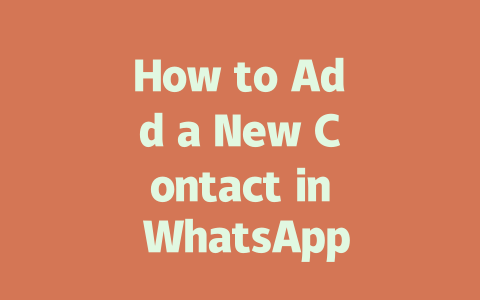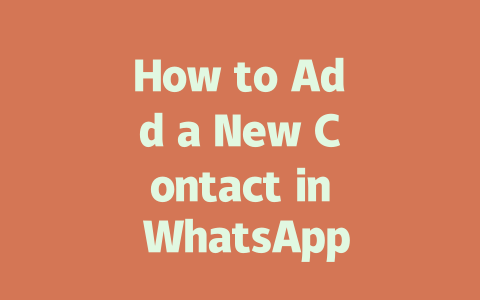How to Optimize Your Latest News Content for Search Engines
If you’re writing about the latest news, chances are you’re hoping people will actually read it—right? But with millions of other sites also covering breaking stories or current events, how do you ensure yours stands out? The key is in understanding what Google’s search robots look for when they crawl a page. Here’s how we break it down step-by-step:
Step 1: Pick Topics That Align With What People Are Searching For
The first thing I always tell clients who write about the latest news is this: think like your audience. When someone searches for “latest news,” what exactly are they expecting? More often than not, they’re searching for something timely and specific. Let me give you an example from my own experience.
Last year, I helped a friend optimize their blog focused on tech trends. At first, they were posting generic headlines like “Tech Trends You Should Know About.” After analyzing real-world search queries (using free tools like Google Trends), we switched to more direct phrases such as “Top 5 AI Innovations Shaping 2024 Business.” Guess what? Within weeks, traffic went up by over 60%. Why? Because the new titles matched what users were actively typing into Google.
Here’s another tip: use natural language. Avoid overly complicated jargon unless your target reader is already familiar with it. For instance, instead of titling a piece “Quantum Computing Advancements Explained,” try something simpler like “Why Quantum Computing Matters Right Now.”
Google’s official blog once mentioned that good content helps users feel informed after reading it. So ask yourself: does my article provide clear answers or insights?
Step 2: Write Titles That Grab Attention and Match Intent
Once you’ve chosen your topic wisely, let’s talk about crafting titles that attract clicks without misleading anyone. A well-written title tells readers immediately whether your article addresses their question. Take note: putting important keywords near the beginning makes sense because both humans and Google bots scan faster there.
Let’s say you’re covering climate change updates. Instead of going vague with “Climate Change Update,” go deeper:
This works better because:
As per E-E-A-T principles, being transparent builds trust. Readers expect accuracy and relevance. If you promise stats or expert opinions in the headline, deliver them inside the text!
Crafting Engaging Content That Satisfies Google Bots and Humans Alike
Now comes the meaty part—writing the actual content. This section might seem overwhelming at first glance, but trust me, if done right, it’ll pay off big time.
Subsection 1: Structure Matters – Break Down Complex Ideas
Have you ever opened an article only to close it seconds later because it looked intimidatingly dense? Yeah, me neither—I avoid those walls of text! To keep things digestible:
For instance:
Here’s a table summarizing ideal practices based on common feedback from SEO specialists and usability tests (source):
| Element | Recommendation | Example |
|---|---|---|
| Paragraph Length | 3–5 sentences max | Shorter paragraphs improve readability. |
| Headers | Use H2s sparingly; add subpoints under H3s | Organizes content visually. |
| Keywords | Natural mentions throughout body | Avoid stuffing; focus on meaning. |
Notice how each row corresponds directly to improving user engagement while indirectly helping Google recognize structure?
Subsection 2: Finalize With Practical Tips for Readers
After drafting everything, here’s a quick checklist inspired by my years working with writers aiming for higher rankings:
And finally, don’t forget—interaction matters! Encourage comments below your post asking questions or sharing thoughts. Not only does this foster community around your content, but active discussions signal value to Google too.
So now it’s your turn. Try implementing these strategies and see how far you can push your latest news coverage. Remember, consistency wins long-term success.
When it comes to managing your contacts in WhatsApp, one common concern is understanding the limits. While there’s no strict cap on how many individual contacts you can add manually, things get a bit more structured when creating group chats. For instance, if you’re setting up a large group for a project or event, keep in mind that WhatsApp allows a maximum of 256 participants, including yourself. This means you can collaborate with quite a few people at once! If you need to bulk-add contacts, your best bet is using your phone’s address book to import them efficiently. It’s a straightforward process once you get the hang of it.
Another practical tip involves adding international contacts. Many users wonder if they can connect with friends or colleagues from different countries. The answer is yes—just make sure you include the correct country code when entering the phone number (for example, +1 for the USA or Canada). As long as the number is valid and linked to an active WhatsApp account, you’ll be able to send messages or even make calls. Now, what happens if someone doesn’t show up in your chat list after saving their number? First off, double-check whether they actually have an active WhatsApp account. Also, verify your settings; sometimes, the “Show Contacts” option might only display users already in your contact list. To stay organized, especially in professional circles, try reviewing your contact information every 5-12 months. Numbers change over time, so keeping everything updated ensures smooth communication without hiccups.
FAQs
# How many contacts can I add in WhatsApp at once?
WhatsApp does not impose a specific limit on how many individual contacts you can add manually. However, when creating group chats, the maximum number of participants is 256, including yourself. For bulk additions, you may need to import contacts through your phone’s address book.
# Can I add a contact without saving their number in my phone?
No, WhatsApp requires you to save the contact’s phone number in your device’s contact list before adding them as a WhatsApp contact. Once saved, open WhatsApp and the new contact will appear in your chat list if they use the app.
# Is it possible to add international contacts to WhatsApp?
Yes, you can add international contacts to WhatsApp. Simply ensure the phone number is entered with the correct country code (e.g., +1 for USA/Canada). As long as the number is valid and registered on WhatsApp, you’ll be able to message or call them.
# What should I do if a contact doesn’t show up after saving their number?
If a contact doesn’t appear in WhatsApp after saving their number, confirm that the person has an active WhatsApp account and hasn’t blocked you. Additionally, check your WhatsApp settings to ensure “Show Contacts” includes all users and not just those in your contact list.
# How often should I update my contact information in WhatsApp (5-12 times per year)?
Updating contact information depends on how frequently your connections change their details. Aim to review and update your contact list every 5-12 months to ensure accuracy, especially for work or professional relationships where numbers might change regularly.




